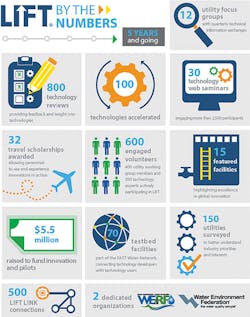Program aims to facilitate adoption of new technologies
By Kelsey Beveridge
Water utilities are facing increasing pressure due to aging assets, declining revenues, tightening permits, and growing water scarcity in many regions. Additionally, the gap between water infrastructure funding needs and available funding continues to widen.
In order to meet these challenges, it is more important than ever for utilities to be proactive in identifying and advancing new technologies that can save costs, improve treatment processes, and benefit the environment. However, the water industry has been traditionally risk averse and conservative when it comes to adopting new technologies. As such, it finds itself at a crossroads and will need to find new ways to manage and share risk when it comes to implementing new technologies.
In response to these needs and challenges, the Water Environment & Reuse Foundation (WE&RF) and the Water Environment Federation (WEF) created the Leaders Innovation Forum for Technology (LIFT), an initiative to help bring innovation into practice and facilitate early adoption of technologies that will help utilities improve their performance and reduce costs.
A recent study by J.D. Power indicates that satisfied customers are the key to water infrastructure investment.
LIFT provides a network of people and resources to help utilities identify new technologies, communicate among facilities, and collaborate on implementation. LIFT can help facility owners and personnel to learn firsthand about the latest technologies, how they can use them in their own facility, and ways to share solutions with peers. Six key elements of the program are described below.
1. LIFT Technology Scans identify and evaluate innovative technologies to inform facility owners and other interested parties in order to promote early adoption of technologies. Technology providers submit their technologies for review and screening by industry experts and potential end users. The technologies promoted through LIFT Technology Scans may be in varying stages of development from emerging and pre-commercial to newly commercialized. The service offers technology providers a platform for introducing their technology to end users while also enabling utilities to learn directly from innovators how the technology functions and how it can be incorporated into their operations.
2. LIFT Link, an online platform, allows users to discover new technologies, connect with others that share similar needs and interests, and collaborate on research and demonstrations. LIFT Link contains profiles of more than 100 technologies accepted through the Technology Scans process that are regularly updated by the providers to share new performance data, enhancements, and progress. The technologies are searchable, which allows utilities to filter directly for the category or technology they are looking for to fill their need.
Additionally, in the Needs Forum, utilities can post priority technical challenges. Other utilities can “follow” a challenge or indicate that they “have the same need,” which sends a signal to the marketplace that opportunities exist for solution providers to address vexing pain points for the industry. It also provides a mechanism for users to identify interested partners for projects and proposals, and for utilities to collaborate in order to share the cost and risk of new technology implementation.
OptiRTC is a good example of a technology that originated as a WE&RF project and has progressed through LIFT. In an effort to look beyond traditional stormwater infrastructure, WE&RF began research on a smart stormwater management concept to demonstrate that the highly distributed real-time control technologies can play a key role in managing urban infrastructure. This led to the formation of an independent company, Opti, which is a cloud-based technology platform for real-time environmental monitoring and control of civil infrastructure.
Technology demonstrations were conducted through LIFT and generated a widespread response to test the technology at scale at watersheds and communities across the country. Now Opti has grown to include more than 130 commercial and public projects across the country and has more than 20 million gallons of storage under active management.
3. In addition to LIFT Link, facility owners can engage in discussions in theLIFT Utility Working Group, a peer-to-peer networking forum on new technology and innovation that includes over 400 facility owner participants. Based on user needs and interests, technologies are narrowed down into 12 specific Focus Area Groups including biological nutrient removal, phosphorus recovery, energy from wastewater, water reuse, and others. Members that have an interest in one of these categories can take part in a Focus Area Group to engage in discussion with other facilities and share experiences in these priority areas.
Focus Area Groups facilitate information sharing on pilots, guidance from experts, and testing and demonstration collaborations. For example, a biological nutrient removal focus group was created in response to increasingly stringent regulations and the rising costs of compliance. Since its inception as LIFT’s first technology focus area, WE&RF has hosted numerous workshops and meetings on the subject and is currently conducting research under a $2.3 million STAR grant to expand nutrient management research.
4. LIFT also presents a unique program for utility personnel to visit technologies of interest. The LIFT SEE IT (Scholarship Exchange Experience for Innovation & Technology) Program, an initiative of WE&RF, WEF, and the National Association of Clean Water Agencies (NACWA), provides scholarships for utility personnel to visit other utilities with innovations of interest and share experiences with peers. In January 2017, 32 staff members from 11 utilities were awarded travel scholarships to visit other facilities across the country and in Europe.
SEE IT provides utility representatives with hands-on interaction with innovative technologies and approaches that they can use to inform technology adoption at their facilities. For instance, a scholarship recipient, City of Raleigh Public Utilities Department, applied to SEE IT to visit utilities in the United Kingdom to explore thermal hydrolysis process (THP) and shortcut nitrogen removal sidestream treatment systems. The City of Raleigh is interested in transitioning to anaerobic digestion with thermal hydrolysis pretreatment to produce Class A biosolids and move toward energy neutrality. As there are few sites within the United States that use THP systems, there are limited options to visit utilities of comparable size and capacity. The City of Raleigh chose to visit Thames Water PLC in West Sussex, UK, because they have a newer, similarly-sized system to what would be used in Raleigh and to gain valuable knowledge that will assist with decision making during design and implementation of their own bioenergy recovery program.
5. LIFT also supports a national network of testbed facilities that assists in the development and piloting of technologies for the water sector. The FAST (Facilities Accelerating Science & Technology) Water Network connects researchers, technology providers, and other innovators with test facilities appropriate for their needs. Users are able to learn about what the facility offers and what they are capable of testing. The test bed network is the result of recommendations from workshops organized by the National Science Foundation, the U.S. Department of Energy, the U.S. Environmental Protection Agency, and WE&RF. Currently, the FAST Water Network includes more than 70 test facilities in the United States and globally, and serves as an impartial party to coordinate their work and scale-up efforts to avoid redundancy.
6. A growing priority for LIFT is fostering relationships among utilities and universities for research and testing of innovative solutions. Such partnerships can help utilities source a low-cost technical solution, provide progressive solutions to problems, and minimize the risk through research and piloting for faster adoption and cost saving. The University-Utility Partnership Program helps utilities develop alliances to implement initiatives such as internships, scholarships, and faculty sabbaticals to encourage growth in innovation. Not only does this benefit universities as an opportunity to learn and contribute to their utility, it also helps the utility identify new talent for staffing and contracting. It exposes students to the water sector and provides them with real-world training and experience, and consequently greater post-graduate employment potential.
The resources available through LIFT enable utilities to gain direct access to the latest water and wastewater technologies and adopt them sooner for cost savings and process improvements. As the interests and needs of the water sector continue to evolve, LIFT helps utilities fill knowledge gaps related to new technologies and provides them with a platform to share solutions to new and ongoing challenges. LIFT provides utilities the guidance, tools, and resources they need to develop and implement innovation programs and helps foster a culture of innovation.
There are many opportunities to be involved with LIFT by joining the Utility Working Group, reviewing new technologies, submitting a technology, becoming a test bed facility, and more. For more information on LIFT and how to get involved, visit www.werf.org/lift.
About the Author: Kelsey Beveridge is a technical writer at WE&RF. Prior to joining the team at WE&RF, she managed fundraising opportunities across the east coast for a breast cancer non-profit. She also has experience with a government affairs firm in Washington D.C., working with associates in the water and environment practice.




